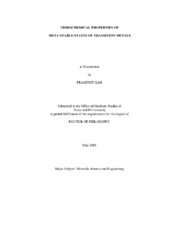| dc.description.abstract | Mechanical forces can be used to trigger chemical reactions through activating
bonds and to direct the course of such reactions in organic materials, particularly in
polymers. In inorganic materials, the small molecules present significant challenges in
directing the reaction kinetics. This dissertation studied the dynamics and kinetics of
oxidation of transitional metals, particularly on tantalum through mechanical forces.
This is a new area of research in surface science.
Experimentally using a combined electrochemical and mechanical manipulation
technique, we compared the equilibrium and non-equilibrium oxidation processes and
states of tantalum. An experimental setup was developed with an electrochemical system
attached to a sliding mechanical configuration capable of friction force measurement.
The surface chemistry of a sliding surface, i.e., tantalum, was controlled through the
electrolyte. The mechanical force was fixed and the dynamics of the surface was
monitored in situ through a force sensor. The formation of non-equilibrium tantalum
oxides was found in fluid environments of hydrogen peroxide, acetic acid and deionized water. We found that the mechanical energy induced the non-stable state reactions
leading to metal-stable oxides.
Analytically, we compared the energy dispersion, reaction kinetics, and
investigate physical chemical reactions. We proposed a modified Arrhenius equation to
predict the effect of mechanical energy on non-spontaneous reaction under nonequilibrium
conditions. At the end, we also propose a modified Pourbaix diagram known
as the Kar-Liang diagram. The Kar-Liang diagram helps to understand the behavior of
tantalum under non-equilibrium conditions. A complete understanding of the
tribochemical reaction of tantalum is achieved through this dissertation.
The dissertation contains six chapters. After the introduction and approach,
oxidation of tantalum is discussed in Chapter IV, kinetics in Chapter V. The nonequilibrium
Kar-Liang diagram is discussed in Chapter VI, followed by conclusion. This
research has important impacts on the field of surface science in understanding the
basics of mechanochemical reactions. The resulting theory is beneficial to understand
chemical-mechanical planarization (CMP) and to optimize the current industrial
processes in microelectronics in making integrated circuits. | en |


